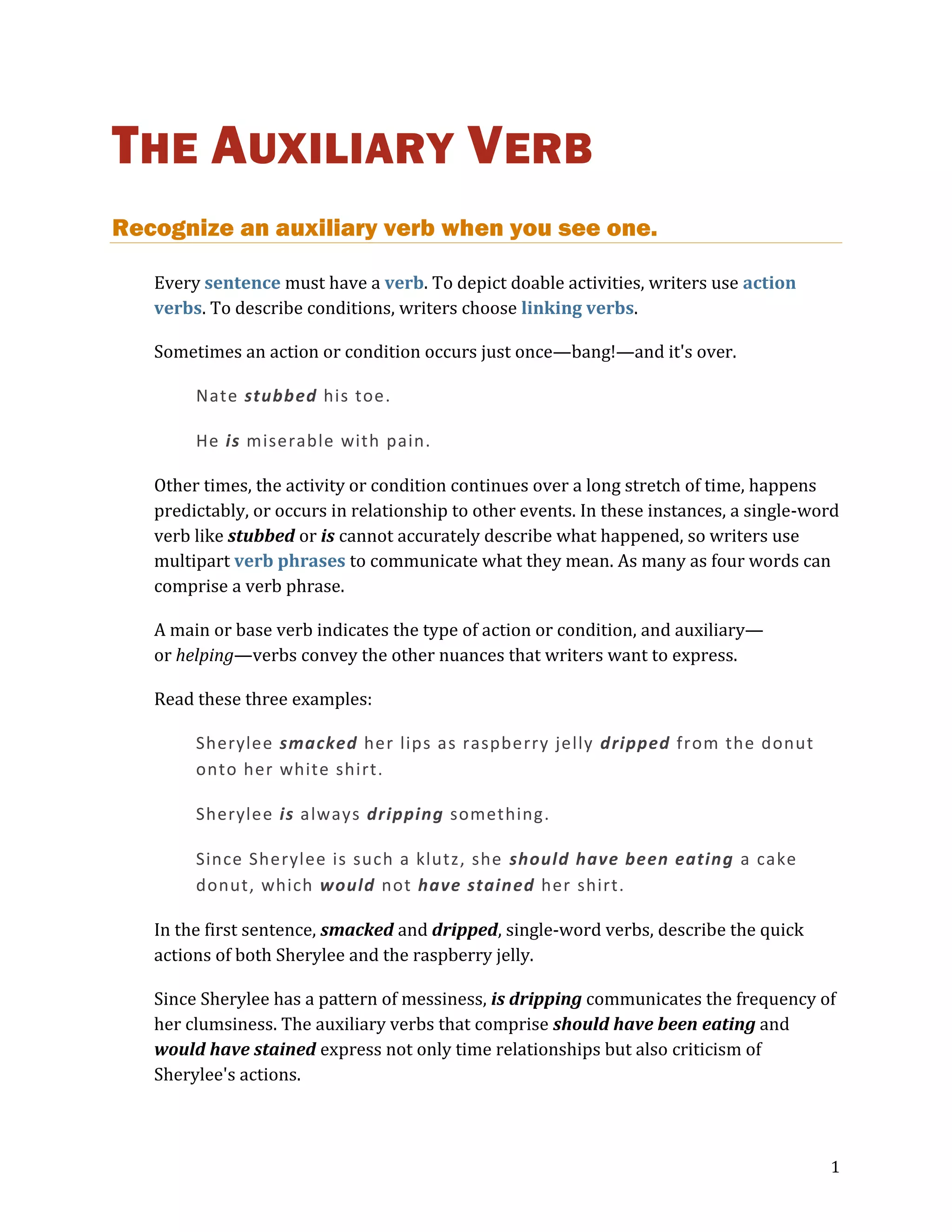The document discusses auxiliary verbs and how they are used to form verb phrases and tenses in English. It defines auxiliary verbs as "helping" verbs that are used along with a main verb to convey meanings like time, aspect, modality, voice, and emphasis. The key auxiliary verbs are be, do, have, and the modal auxiliaries (can, could, may, etc.). Examples are provided to illustrate how auxiliary verbs are used to form the present, past, future, progressive, perfect, and emphatic tenses, as well as passive voice. The roles and functions of specific auxiliary verbs like be, do, have, and the modal auxiliaries are explained in detail.

![2
Below are the auxiliary verbs. You can conjugate be, do, and have; the modal
auxiliaries, however, never change form.
BE DO HAVE
am
is
are
was
were
being
been
does
do
did
has
have
had
having
MODAL AUXILIARIES [NEVER CHANGE FORM]
can, could, may, might, must, ought to, shall, should, will, would
Understand the dual nature of be, do, and have.
Be, do, and have are both stand-alone verbs and auxiliary verbs. When these verbs
are auxiliary, you will find them teamed with other verbs to complete the verb
phrase.
Compare these sentences:
Freddy is envious of Beatrice’s steaming bowl of squid eyeball stew.
Is = linking verb.
Freddy is studying Beatrice’s steaming bowl of squid eyeball stew
with envy in his eyes.](https://image.slidesharecdn.com/auxiliaryverb-181117121936/75/Auxiliaryverb-2-2048.jpg)



![6
The double bacon cheeseburger was being devoured by Frank.
His enjoyment was envied by everyone.
Notice how wordy and clunky passive voice is! Now you know why English teachers
tell you to avoid it!
Form perfect tenses with the auxiliary verb have.
All perfect tenses use a form of have.
FORMS OF HAVE
has, have, had, having
PRESENT PERFECT
Present perfect follows this pattern:
HAS OR HAVE + PAST PARTICIPLE
Use the present perfect tense to convey an action or condition that began in the
past but continues [or is finished] in the present.
Marge has bought earplugs to drown out her husband's snoring.
Has = auxiliary verb; bought = past participle completing the verb
phrase.
The earplugs have saved Marge's marriage to George.
Have = auxiliary verb; saved = past participle completing the verb phrase.
PAST PERFECT
Past perfect follows this pattern:
HAD + PAST PARTICIPLE](https://image.slidesharecdn.com/auxiliaryverb-181117121936/75/Auxiliaryverb-6-2048.jpg)

![8
FORM OF DO + SUBJECT + MAIN VERB ... ?
Read these samples:
I did not eat your leftover pizza!
Did = auxiliary verb; eat = main verb completing the verb phrase.
Do you always accuse the first person you see?
Do = auxiliary verb; accuse = main verb completing the verb phrase.
Doesn't the evidence point to Samuel, who still has a bit of black olive
stuck to his front tooth?
Does = auxiliary verb; point = main verb completing the verb phrase.
Understand the job of modal auxiliary verbs.
Modal auxiliary verbs never change form. You cannot add an ed, ing, or s ending to
these words. They have only one form.
MODAL AUXILIARIES [NEVER CHANGE FORM]
can, could, may, might, must, ought to, shall, should, will, would
You can use modal auxiliary verbs in these patterns:
MODAL + MAIN VERB
MODAL + BE + PRESENT PARTICIPLE
MODAL + HAVE + PAST PARTICIPLE
With modal auxiliaries, you can indicate necessity or obligation:
To lose her orange glow, Yvonne should eat fewer carrots.](https://image.slidesharecdn.com/auxiliaryverb-181117121936/75/Auxiliaryverb-8-2048.jpg)
